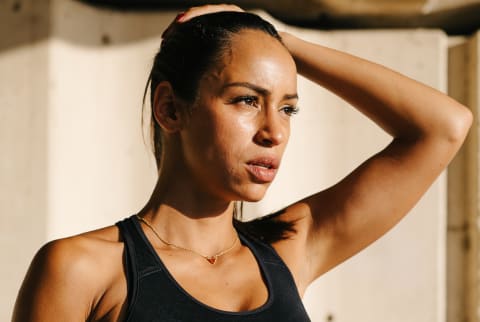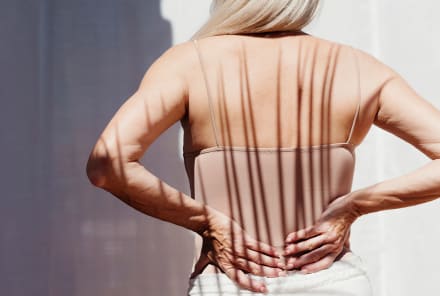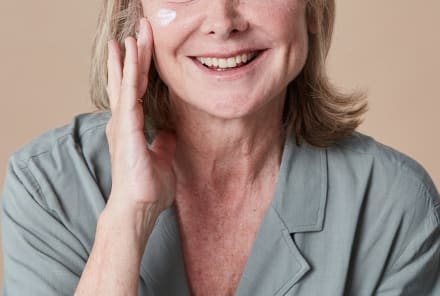Advertisement
Post-Workout Headaches: Why You Get Them & How To Manage, From Fitness Experts


Stress is a well-known cause of tension headaches, which thankfully can be avoided with proper stress-reduction techniques. One great way to ease stress is through exercise—but in certain circumstances that physical exertion can simply exacerbate the headache (frustrating, we know).
To better understand why exertion headaches are a thing and how to manage them, mbg spoke with neurologists, physicians, and personal trainers. Here's what they have to say about the post-workout pain.
Why do we get headaches?
It's first important to note that there are many possible causes of headaches, plus the type of headache and severity can also vary. A few common causes are neck pain, orthostatic intolerance1, inflammatory foods, and an altered gut microbiome, board-certified neurologist Ilene Ruhoy, M.D., Ph.D., tells mbg. Poor sleep, stress, and exercise may also be culprits. Try one of our top picks for sleep aids here.
Though working out is intended to improve physical and mental health by increasing endorphins, some people experience less-pleasant residual effects, like exertion headaches.
Reasons for exertion headaches:
Blood flow
"Commonly, exertion headaches are theorized to be caused by a dysregulation in the cerebrovasculature," functional medicine physician Leah Johansen, M.D., says. Meaning, the blood vessels in the brain are not functioning properly.
"When you exercise, the blood vessels in your brain dilate or distend in response to increased blood flow," she says, "which can increase intracranial pressure and venous congestion, leading to head pain." There are also a few factors that can influence blood flow—more on that below.
Dehydration
"The most common reason for post-exertion headache is dehydration," Ruhoy says. "With strenuous exercise, increased blood flow and supply is important for the organs and muscles of the body. When we are dehydrated, we have less volume inside our vessels, and flow of blood is more difficult, especially against gravity up into the head."
Dehydration is common during exercise, especially when working out in hot weather or any instance that leads to increased sweat. This is why it's important to hydrate before exercise and during exercises to make up for the lost fluid.
Too much sunlight
Spending too much time in the sun can lead to exertion headaches—even if exercise isn't involved—but especially if it is. That's mainly because heat from the sun can lead to dehydration, but research also shows bright lights can also trigger headaches in people with migraines2. So if you're noticing pain after running outdoors, this might be a contributing factor.
Low blood sugar
Blood sugar is one of the brain's primary sources of energy, and if the body is not properly fueled (aka fed) before working out, it can lead to low blood sugar or hypoglycemia in people with diabetes. One of the primary symptoms of this condition is a headache.
Though people without diabetes can experience hypoglycemia3, it's extremely rare.
How to manage post-workout headaches
When a post-workout or exertion headache strikes, Johansen says to cool down properly and adequately hydrate with an electrolyte solution. (Here: an easy homemade electrolyte drink.)
Though over-the-counter anti-inflammatory drugs are only meant to be used in the short term, Johansen says they can be helpful at providing temporary relief from pain. "It's also important to be careful using nonsteroidal anti-inflammatory drugs (NSAIDs), as they can take a hit to the kidneys and cause stomach irritation," she adds.
Certified personal trainer Jason Williams, NASM-CPT, suggests some restorative movements, like this foam-rolling exercise:
- Lie down with a foam roller behind the neck.
- Move the head side to side, then up and down, massaging the base of the skull.
Engaging in head, neck, and trapezius stretches, or icing the back of the head/neck for 20 minutes can also be helpful, Williams says.
How to prevent post-workout headaches
To prevent post-workout headaches altogether, Ruhoy emphasizes the importance of adding electrolytes when hydrating, the day before, directly before, and during exercise.
"Electrolytes improve the osmolality of the plasma, and hence our kidneys won't flush as much free water out," she explains. "So added electrolytes can help maintain the intravascular volume." In other words, this helps to keep the blood circulating properly in the brain.
Williams also recommends stretching the head and the neck or applying a heating pad to the back of the neck to loosen and warm up the area prior to working out.
Paying attention to breath and activating the parasympathetic nervous system can also be critical, according to Johansen. "Research has shown pranayama-type breathing training, like the infamous Wim Hof Method, can help regulate your parasympathetic regulation, reduce proinflammatory cytokines, and increase anti-inflammatory cytokine IL-10," she says.
The takeaway
Depending on the severity, exercise-induced headaches may need to be evaluated by a doctor. Particularly if the symptoms are new or occur jointly with double vision, shortness of breath, nausea, or vomiting, Johansen says.
When mild or triggered by dehydration, too much sun, or low blood sugar, the symptoms can commonly be managed. Hydration is key—water, electrolytes, and even certain teas may help quell those headaches.
Watch Next
Enjoy some of our favorite clips from classes
Enjoy some of our favorite clips from classes
What Is Meditation?
Mindfulness/Spirituality | Light Watkins
Box Breathing
Mindfulness/Spirituality | Gwen Dittmar
What Breathwork Can Address
Mindfulness/Spirituality | Gwen Dittmar
The 8 Limbs of Yoga - What is Asana?
Yoga | Caley Alyssa
Two Standing Postures to Open Up Tight Hips
Yoga | Caley Alyssa
How Plants Can Optimize Athletic Performance
Nutrition | Rich Roll
What to Eat Before a Workout
Nutrition | Rich Roll
How Ayurveda Helps Us Navigate Modern Life
Nutrition | Sahara Rose
Messages About Love & Relationships
Love & Relationships | Esther Perel
Love Languages
Love & Relationships | Esther Perel
What Is Meditation?
Box Breathing
What Breathwork Can Address
The 8 Limbs of Yoga - What is Asana?
Two Standing Postures to Open Up Tight Hips
How Plants Can Optimize Athletic Performance
What to Eat Before a Workout
How Ayurveda Helps Us Navigate Modern Life
Messages About Love & Relationships
Love Languages
Advertisement

This Supplement May Remarkably Benefit Those With A High Risk Of Alzheimer’s
Molly Knudsen, M.S., RDN

Want To Be Metabolically Healthy? Study Shows An Underutilized Approach
Molly Knudsen, M.S., RDN

Don’t Eat A Lot Of Meat? Make Sure You Take This Supplement Daily
Molly Knudsen, M.S., RDN

Study Reveals 2 Habits That Are Early Signs Of Muscle Loss In Women
Molly Knudsen, M.S., RDN

This Supplement May Remarkably Benefit Those With A High Risk Of Alzheimer’s
Molly Knudsen, M.S., RDN

Want To Be Metabolically Healthy? Study Shows An Underutilized Approach
Molly Knudsen, M.S., RDN

Don’t Eat A Lot Of Meat? Make Sure You Take This Supplement Daily
Molly Knudsen, M.S., RDN

Study Reveals 2 Habits That Are Early Signs Of Muscle Loss In Women
Molly Knudsen, M.S., RDN

This Supplement May Remarkably Benefit Those With A High Risk Of Alzheimer’s
Molly Knudsen, M.S., RDN

Want To Be Metabolically Healthy? Study Shows An Underutilized Approach
Molly Knudsen, M.S., RDN

Don’t Eat A Lot Of Meat? Make Sure You Take This Supplement Daily
Molly Knudsen, M.S., RDN

Study Reveals 2 Habits That Are Early Signs Of Muscle Loss In Women
Molly Knudsen, M.S., RDN

This Supplement May Remarkably Benefit Those With A High Risk Of Alzheimer’s
Molly Knudsen, M.S., RDN

Want To Be Metabolically Healthy? Study Shows An Underutilized Approach
Molly Knudsen, M.S., RDN

Don’t Eat A Lot Of Meat? Make Sure You Take This Supplement Daily
Molly Knudsen, M.S., RDN

Study Reveals 2 Habits That Are Early Signs Of Muscle Loss In Women
Molly Knudsen, M.S., RDN










